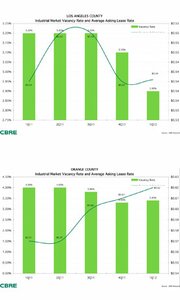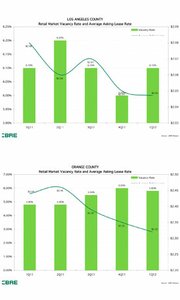Real Estate Vacancy Increases
Retail vacancy rates slightly increased in Los Angeles County, according to real estate firm CBRE.
The county’s overall vacancy rate climbed to 6.1 percent of the county’s commercial real estate base in the first quarter of 2012, compared with a vacancy rate of 6 percent in the fourth quarter of 2011. The average asking lease rate per square foot remained flat at $2.05.
Commercial vacancy has steadily increased in Los Angeles County since the Great Recession. In the fourth quarter of 2007, the overall vacancy rate was 3 percent, according to CBRE. Vacancy peaked at 6.3 percent in the third quarter of 2010.
“In L.A., the market is quite flat overall—although the rate definitely inched up ever so slightly in Q1,” said Gary Bargona, the Southern California research manager for CBRE. “The rate has hovered between 6 percent and 6.2 percent for the past six quarters.”
For neighboring Orange County, commercial-vacancy rates declined to 5.8 percent of the county’s real estate stock during the first quarter of 2012. During the fourth quarter of 2011, Orange County’s commercial vacancy was 6 percent. Vacancy declined because more than 108,000 square feet of commercial space was leased in South Orange County. A big chunk of that leased space was taken up by an emporium for Oklahoma City–headquartered crafts retailer Hobby Lobby. It leased 78,000 square feet at The Marketplace mall in Laguna Niguel. The superstore opened June 4.
In Orange County, the average asking lease rate per square foot declined to $2.32 in the first quarter of 2012, compared with an average asking lease rate of $2.35 per square foot in the fourth quarter of 2011.
For veteran commercial real estate broker Chuck Dembo, business has not changed much on Los Angeles’ premier retail streets from the fourth quarter of 2011 to the first quarter of this year. “The landlords are more aggressive, the market is tightening, and they are raising their rents.” Dembo is a partner with Beverly Hills–based Dembo Associates.
However, the market also seems to be in a transition. Boutique space on many of Los Angeles’ top streets seems to be filling up. Earlier this year, Rodeo Drive in Beverly Hills claimed the lowest commercial vacancy in recent memory, with only about five storefronts vacant.
After some high-profile departures from Los Angeles’ West Third Street, the street is filling up with new boutiques. West Third Street veterans Hillary Rush and EM & Co. shuttered their operations on the street earlier this year. But new stores have moved onto the street, such as a new location for Seattle-based boutique Show Pony as well as the first boutiques from Los Angeles–based brands Shareen and William B. + Friends.
Many high-profile specialty retailers continue to cut back. On May 25, Wet Seal chief executive Susan McGalla said the company will reduce its store-opening plan to 20 to 22 boutique openings for Wet Seal for the rest of the year, a decrease from 25 to 30 openings previously forecast.
Retailers also are looking for smaller storefronts for their boutiques. VF Corp.’s 7 For All Mankind recently moved out of its shop on Los Angeles’ Robertson Boulevard because the space was too big. The company will focus on what is a smaller footprint for them—2,000 square feet—said Barry Miguel, 7 For All Mankind’s president.
Space vacated by bigger specialty retailers has given unique opportunities to some boutiques, said Gila Leibovitch, who recently opened a new location for her Premier boutique. The company opened a new boutique at the exclusive Santa Monica Place mall in Santa Monica, Calif., last month. But she advised other retailers to carefully weigh all of the benefits of opening a new location before signing any leasing papers.
“Expansion makes sense only if you can negotiate a great lease and really have a niche or concept that stands out,” Leibovitch said.—Andrew Asch























